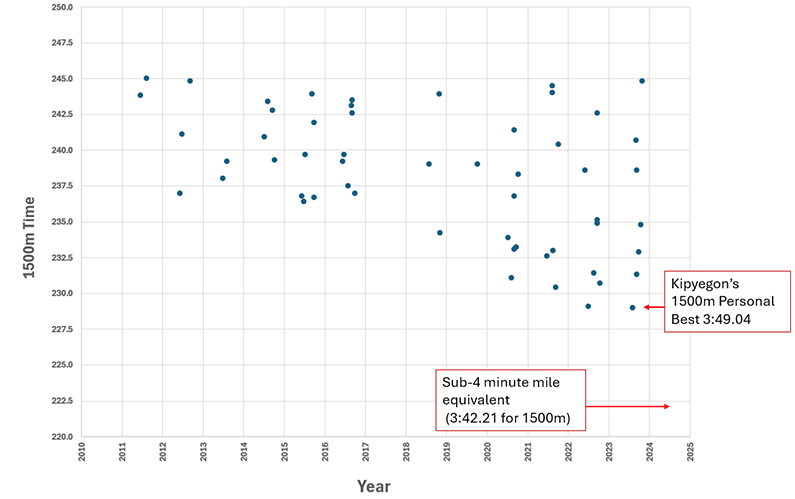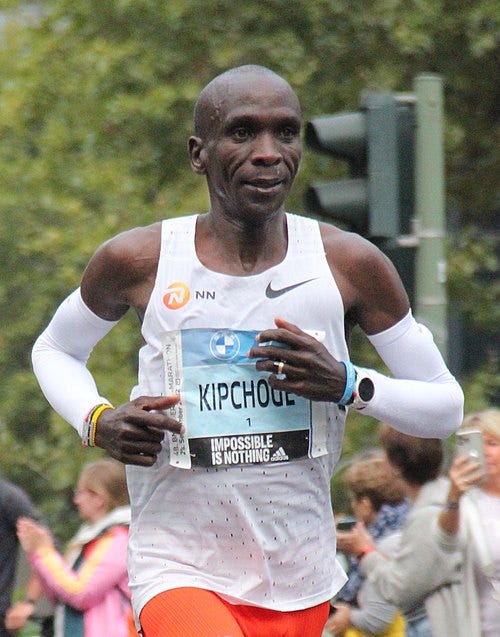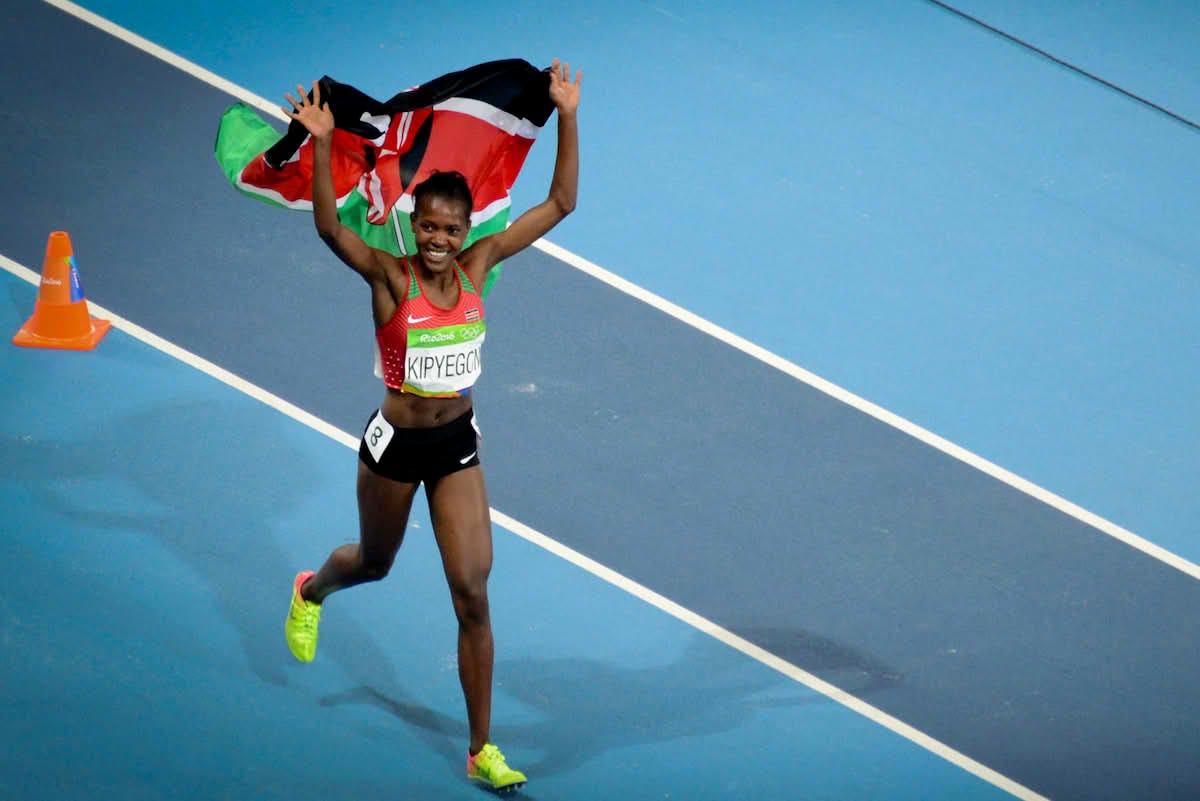Faith Kipyegon and the 4-Minute Mile: What Science Says, and What It Can’t
She’s already the fastest woman in history. Whether she breaks four or not, let’s keep the hype in perspective — and the science honest.
Can Faith Kipyegon Run a Sub-4 Minute Mile? Science, Assumptions, and Realism
Faith Kipyegon, the current women’s mile world-record holder with an astonishing 4:07.64, is aiming for another historic milestone — becoming the first woman ever to run under 4 minutes for the mile. On June 26, Kipyegon will attempt to translate recent scientific research about aerodynamic optimization into a groundbreaking reality, inspired by Eliud Kipchoge’s successful sub-2-hour marathon project.
The Plan: Aerodynamic Optimization
Kipyegon’s sub-4 attempt is rooted in reducing aerodynamic drag through optimal drafting. A recent modeling study by Rodger Kram, Shalaya Kipp, and their colleagues suggested that, with ideal drafting conditions—pacers positioned both in front and behind — Kipyegon could potentially achieve a time of 3:59.37. However, this scenario assumes perfect pacing, flawless drafting conditions, and Kipyegon performing at or above the fitness level when she set her current world record.
The Nuances of the Research
When the study was released in February 2025, I reviewed and discussed it in detail for NPR’s Fresh Air. Let me emphasize clearly: unlike some flawed research we frequently critique on Beyond the Abstract, this study is scientifically rigorous and notably transparent.
The authors openly disclose numerous assumptions and limitations underpinning their model, highlighting inherent uncertainties. Their calculations rely extensively on previous studies — often involving male athletes — and thus represent theoretical estimates rather than direct, measured outcomes.
Importantly, the researchers themselves avoid making exaggerated or misleading claims. They explicitly present their findings as hypothetical scenarios, carefully outlining the realism and limitations of each assumption.
Unfortunately, some media coverage has oversimplified these findings, transforming cautious theoretical conclusions into exaggerated headlines. Some even suggest that a sub-4 mile is imminent. This misrepresents the careful nature of the research.
Additionally, real-world racing conditions introduce complexities absent from theoretical models. Particularly in shorter events like the mile, perfect drafting is challenging — especially during the final lap, when athletes accelerate and stride patterns shift. Historical men’s records, such as Jakob Ingebrigtsen’s indoor mile and Alan Webb’s American record, were achieved largely without drafting in their critical final laps (both videos are worth a watch!).
A 3% Leap is Huge
Moving from 4:07.64 to sub-4 represents a greater than 3% improvement — an enormous physiological leap at elite levels. Top athletes like Kipyegon already benefit maximally from advanced training and shoe technology.
Every world-record performance represents an extreme peak, not always repeatable. Kipyegon ran her mile record two years ago, and last year set a remarkable 3:49.04 in the 1500m, roughly equivalent to a 4:07 mile. She’s improved her marks by two seconds since 2021. But, to achieve a sub-4 mile (3:59.99), she would need a 1500m equivalent of about 3:42.21 — nearly 7 seconds faster than her best.
While improvements from age 30 to 31 can occur, a breakthrough performance at this stage typically demands extraordinary circumstances. It’s realistically possible for her to run faster than her previous 4:07.64 — but to break 4 minutes, significant aerodynamic assistance combined with exceptional fitness would be required.

The Real World Evidence of Extreme Drafting
When Eliud Kipchoge broke the 2-hour marathon barrier (1:59:40.2), the special conditions yielded about a 1.6% improvement over his competition best (2:01:39, set the previous year). Expecting nearly double the aerodynamic benefit for Kipyegon in a shorter, faster race is ambitious.

Additionally, effective drafting in a fast, short race like the mile involves precise coordination — small miscalculations can have large consequences, like tripping. While carefully orchestrated conditions reduce risks, perfect execution remains challenging.
Historical Precedents and Possibilities
Despite the substantial challenge, history demonstrates that extraordinary leaps occasionally happen without optimized conditions:
Paula Radcliffe shattered expectations in 2003 when she improved her previous world record marathon by nearly two minutes. Yet, her 2:15:25 finish was only a 1.3% improvement from her previous best. (This is one of my favorite videos of toughness in running history)
Tigst Assefa’s 2023 marathon (2:11:53) bested Brigid Kosgei’s previous world record (2:14:04) by over two minutes. Again, this minute improvement in the world record was only a 1.6% change.
Bob Beamon’s iconic long jump in 1968 stood unmatched for 23 years. His giant leap improved the previous world record by 6.6%.
If Kipyegon performance improves by 1.5% (itself a remarkable leap), she would run approximately 4:03.93. Perhaps aerodynamic optimization could bridge the remaining gap to sub-4.
Context and Realism
It's crucial to contextualize Kipyegon’s attempt properly. Without that context, failing to achieve an ambitious and somewhat arbitrary goal could unjustly overshadow her extraordinary accomplishments.
The sub-4 minute mile is culturally significant but physiologically arbitrary. Humans gravitate toward symbolic milestones — like Roger Bannister’s iconic 3:59.4 (also worth a watch!). Yet Bannister’s achievement remains famous primarily because we decided it was a meaningful barrier at that time. How many people can name the first man to break 3:57? (Answer at bottom).
Kipyegon is already one of the greatest distance runners the history of track and field. She does not need to break 4 minutes to be seen as an inspiration or as a benchmark of women’s athletic potential. If we create unrealistic expectations, we risk turning an inspiring effort into a story of disappointment. We shouldn’t allow that to happen — not to her, or to women’s sport.
Celebrating her attempt is important. But we must do it with realism and respect. If she succeeds, it will be historic. If she doesn’t, her legacy will be just as strong. This is not a make-or-break moment. It’s one thrilling chapter in an already extraordinary story.
Biological Constraints (and Why They Matter)
The excitement surrounding a woman attempting to break 4 minutes also underscores the biological differences between male and female athletes. This year alone, nine high school boys in the U.S. have already broken that barrier. That fact doesn't diminish Kipyegon's pursuit—it simply emphasizes biological reality.
Men and women differ in anatomy and physiology: muscle mass, bone structure, hemoglobin levels, hormonal environments, biomechanics, and even training adaptation. These are not judgments of worth, but biological facts with measurable effects on performance.
Understanding these differences is precisely why women’s sports exist as a protected category for biological females. Kipyegon exemplifies the power of that structure. She is competing within her category at the absolute limit of human potential—and that should be celebrated on its own terms.
She is already the fastest woman to run a mile in history. That should be more than enough to earn universal admiration. Her performances don’t need to be validated by comparison to male times or cultural benchmarks. They speak for themselves.
Final Thoughts
Kipyegon doesn’t need to break 4 minutes to be a leader in sport or an inspiration to athletes worldwide. She earned that role when she ran 3:51.29 to win Olympic gold in 2024. She has nothing to prove — and she owes us nothing.
But it is undeniably gutsy of her to try. If she succeeds, it will be an epic moment — akin to Roger Bannister’s legacy-defining run. If she doesn’t, it takes nothing away from what she has already accomplished.
Her sub-4 attempt is thrilling, inspiring, and deeply rooted in scientific curiosity and sporting ambition. Regardless of the outcome, her legacy is secure. This isn’t about proving that women “can do it.” It’s about celebrating a once-in-a-generation athlete doing what she does best: pushing limits.
I’ll be cheering loudly — not because she needs to prove anything, but because great performances deserve to be celebrated.
ANSWER TO TRIVIA: Herb Elliot was the first to break 3:57, when he ran a 3:54.5 in 1958.
I’ve shared my thoughts on the science, the symbolism, and the realism of Faith Kipyegon’s sub-4 mile attempt — but I’d love to hear yours.
What do you think will happen on June 26?
Do you believe she’ll break 4 minutes?
And how much weight do you think we should place on this milestone — scientifically or culturally?
Leave a comment with your predictions, reactions, or critiques. I’ll be reading.






“Without that context, failing to achieve an ambitious and somewhat arbitrary goal could unjustly overshadow her extraordinary accomplishments.” Love that quote
I enjoyed reading this post and some of the links provided. The video of Roger Bannister's first 4 minute mile run at Oxford in 1954 was the most authentic, and in my humble opinion, the most accurate report of factors that lead to the breaking any human barrier. He points to the luck of in the moment weather and the influence of his friends who assisted his attempt giving him the "extra spurt to go on". The human effort in using science to promote progress is admirable, but it seems there is usually an innate human "x" factor involved in real breakthroughs. Thanks for an inspiring read, James.